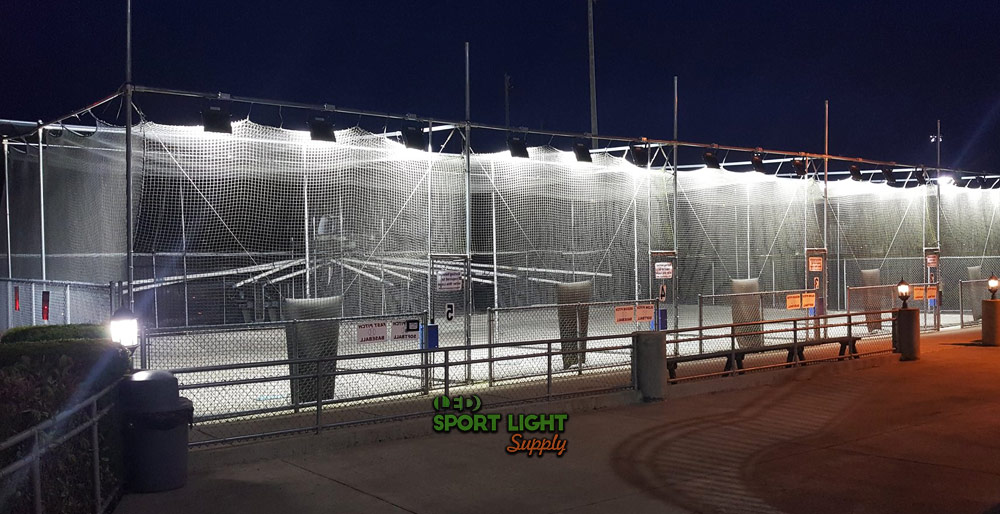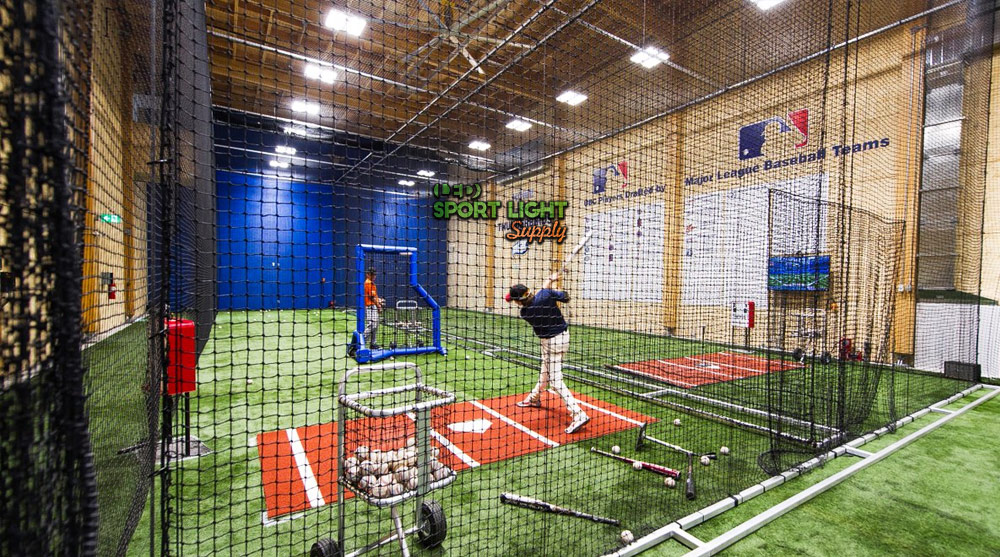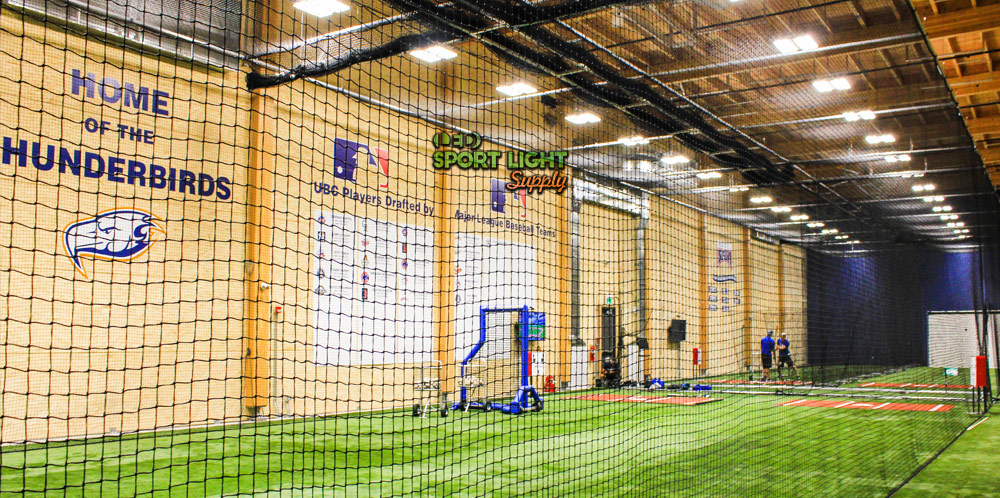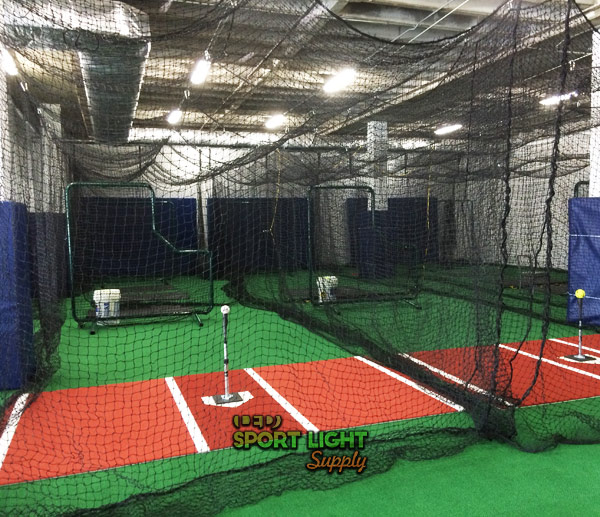A key skill for softball and baseball players is the ability to hit the ball effectively, and the best place to hone this skill is in a batting cage. Batting cages can be found both outdoors and indoors, but regardless of the location, proper lighting is essential for evening practice sessions. It’s not just about illuminating the space; using the right lighting can significantly enhance the user experience and improve training outcomes. This guide is designed to deepen your understanding of the importance of proper lighting in batting cages.
Table of Contents
ToggleOutdoor Batting Cage Lighting Ideas

When setting up an outdoor batting cage, one critical aspect to consider is the lighting system. The right lighting ensures that practice sessions can extend into the evening without compromising the player’s ability to see the ball clearly. Proper lighting is essential because it eliminates shadows and glare, which can disrupt the hitter’s focus and affect performance.
What Lights Should Be Used for Outdoor Batting Cages?
Selecting the correct lights for outdoor batting cages requires careful consideration of several factors. The most important goal is to provide consistent and uniform lighting that allows players to track the ball’s movement accurately. Variations in light intensity along the ball’s trajectory can create optical illusions, making the ball appear to change speed and potentially throwing off the hitter’s timing. Therefore, it’s essential to choose lights that minimize these issues and avoid creating glare.
Flood Lights
Floodlights are a popular choice for outdoor batting cages, especially for those measuring around 70×40 feet with a height of 12 feet. These lights can be mounted close to the cage and are designed to flood the entire area with uniform light. This setup ensures that every part of the cage is evenly lit, which is crucial for maintaining consistent visibility for the batter. When installing floodlights, it’s important to position them carefully to avoid glare and protect them from damage by fast-moving balls. Using anti-shock lenses can be a good preventive measure.
Spot Lights
Alternatively, spotlights can be used to illuminate a batting cage from a distance. These lights have a narrower beam, which can be directed precisely to cover the 70×40 feet area of the cage. Spotlights are often mounted on existing poles that serve other purposes, making them a versatile option. When using spotlights, it’s essential to ensure they are positioned at the correct height and angle to provide consistent lighting without creating shadows or glare.
Height of Installation
The height at which the lights are installed will depend on whether you are using floodlights or spotlights. After determining the appropriate height, you’ll need to select a beam angle that provides uniform coverage of the batting cage while minimizing glare. The installation height and beam angle work together to ensure the entire area is well-lit, creating the ideal environment for practice.
Beam Angles
For spotlights, the optimal beam angles typically range between 25 and 40 degrees, depending on the height of the installation. Floodlights, on the other hand, may require wider beam angles, especially if mounted lower. A variety of beam angles are available, allowing you to choose the one that best suits your specific setup and lighting needs.
Indoor Batting Cage Lighting Ideas

Indoor batting cages require a different approach to lighting compared to outdoor setups. The enclosed space and ceiling height play significant roles in determining the type and placement of lights. Proper indoor lighting enhances visibility and ensures a safe and effective practice environment.
What Lights Should Be Used for Indoor Batting Cages?
Low Bay Lights
Low bay lights are ideal for indoor batting cages with ceiling heights of less than 20 feet. These lights are designed to provide adequate illumination for lower ceilings while maintaining a wide beam spread. The amount of lighting needed will vary based on the cage’s intended use. For recreational use, lower light levels of around 200 to 300 lux may suffice. However, for more serious training, higher levels of 400 to 500 lux are recommended to ensure the ball is clearly visible at all times.
High Bay Lights

For indoor cages with ceiling heights over 20 feet, high bay lights are more suitable. These lights come in various designs, including UFO, Linear, and Vapor tight high bay lights. LED lights are often preferred due to their energy efficiency and long lifespan, making them a cost-effective choice despite a higher initial investment. High bay lights provide more concentrated lighting, and when installed correctly, they help achieve uniform light distribution across the cage.
UFO High Bay Lights
UFO High Bay lights are circular lights that resemble a UFO shape. They are designed to optimize light coverage without the need for large reflectors, making them a popular choice for batting cages. Their compact design allows for easy installation and maintenance while providing powerful illumination.

Light Tubes
Light tubes, such as LED linear tubes, are commonly used in indoor settings. These lights are an energy-efficient alternative to traditional fluorescent tubes, consuming up to 60% less electricity. Light tubes can be arranged to provide even coverage across the entire batting cage, ensuring consistent lighting for all activities.
Height of Installation
When designing an indoor batting cage, it’s important to account for the height of the cage, including any ductwork or pipes that might be present. A minimum clearance of 12 feet is recommended to ensure sufficient space for the lights and to prevent any interference with practice.
Beam Angles
The beam angle of your lights will depend on the ceiling height. For high ceilings, a narrower beam angle of around 40 degrees may be sufficient, while lower ceilings may require a wider angle, ranging from 60° to 90°, to ensure adequate light coverage. Selecting the right beam angle is crucial to achieving uniform lighting and avoiding dark spots or glare within the batting cage.
Where to Put the Indoor Batting Cage Lights
The placement of lighting in an indoor batting cage depends significantly on the cage’s specific location and structure. If your facility has a ceiling that can support lighting fixtures, mounting lights directly on the ceiling is a straightforward option. However, in cases where ceiling mounting is not possible, you may need to install mounting poles. For low bay settings, it may be necessary to use four to six poles to ensure adequate light coverage. These poles should be positioned just above the netting and angled inward to create overlapping beams that provide uniform illumination across the entire cage.
When placing lights just above the netting, it’s essential to consider the possibility of the netting becoming loose or a ball impacting the lights. In such situations, using impact-resistant lighting fixtures is recommended to prevent damage and ensure the safety of the equipment.
Tips to Select the Best Batting Cage Lights
Benefits of LED over Halogen and Metal-Halide
When choosing lighting for a batting cage, you’ll likely encounter three main types: Halogen, Metal-Halide, and LED. Each has its advantages and drawbacks, which are worth considering based on your specific needs.
Halogen
Halogen lamps operate by passing electricity through a filament, which generates both heat and light. While they are relatively inexpensive, they are not very energy-efficient as most of the energy is converted into heat rather than light. Additionally, the high heat output can make them less suitable for environments where temperature control is important.
Metal-Halide
Metal-Halide lamps use gas to produce light, making them more energy-efficient than Halogen lamps. However, they still have significant downsides. Metal-Halide lamps tend to lose around 25% of their performance after just 250 hours of use and have a shorter lifespan overall. They also require a cooling period after being switched off before they can be turned back on, which can be inconvenient for continuous use.
LED Lights
LED lights are a more recent and increasingly popular option for sports lighting, including batting cages. They produce minimal heat compared to Halogen and Metal-Halide lamps, which enhances their efficiency and makes them safer to use in enclosed spaces. Although LED fixtures can be larger, their benefits far outweigh this drawback. LEDs are highly energy-efficient, require less frequent replacement, and ultimately offer cost savings on both electricity and maintenance.
Using Solar LED Lights
For batting cages located in areas without access to a traditional power supply, solar LED lights provide an excellent alternative. Introduced by Philips in 2009, portable solar-powered LED systems can illuminate a space for up to eight hours on a single charge, making them a practical solution for off-grid installations.
Dusk to Dawn Lights
For facilities that require automated lighting, Dusk to Dawn systems are an ideal choice. These lights are designed to turn on at dusk and off at dawn, with the option to customize timings to suit specific needs. This system is particularly useful for sports complexes that wish to minimize manual intervention while ensuring the batting cage is always adequately lit during operating hours.
Larger Beam Angle Benefits for Broader Coverage
Selecting lights with larger beam angles can help achieve more uniform lighting coverage across the batting cage. Modern lighting design often involves using technology to calculate beam angles and overlaps, ensuring that the entire area is well-lit without creating overly bright or dark spots.
Power and Lumen Selection
The amount of light needed for a batting cage depends on its intended use. For recreational batting cages, a light intensity of 200-300 lux is typically sufficient. However, for cages used for training or more serious practice sessions, lighting with 400-500 lumens is recommended to provide better visibility and enhance the training experience.
Conclusion
This guide aims to provide valuable insights into the importance of proper lighting for batting cages. Whether you’re setting up an indoor or outdoor cage, considering the right type of lighting and its placement is crucial. Proper lighting not only enhances the overall experience but also ensures safety and effectiveness during practice sessions. We hope this guide has prompted you to think more critically about your lighting options as you plan your batting cage setup.
